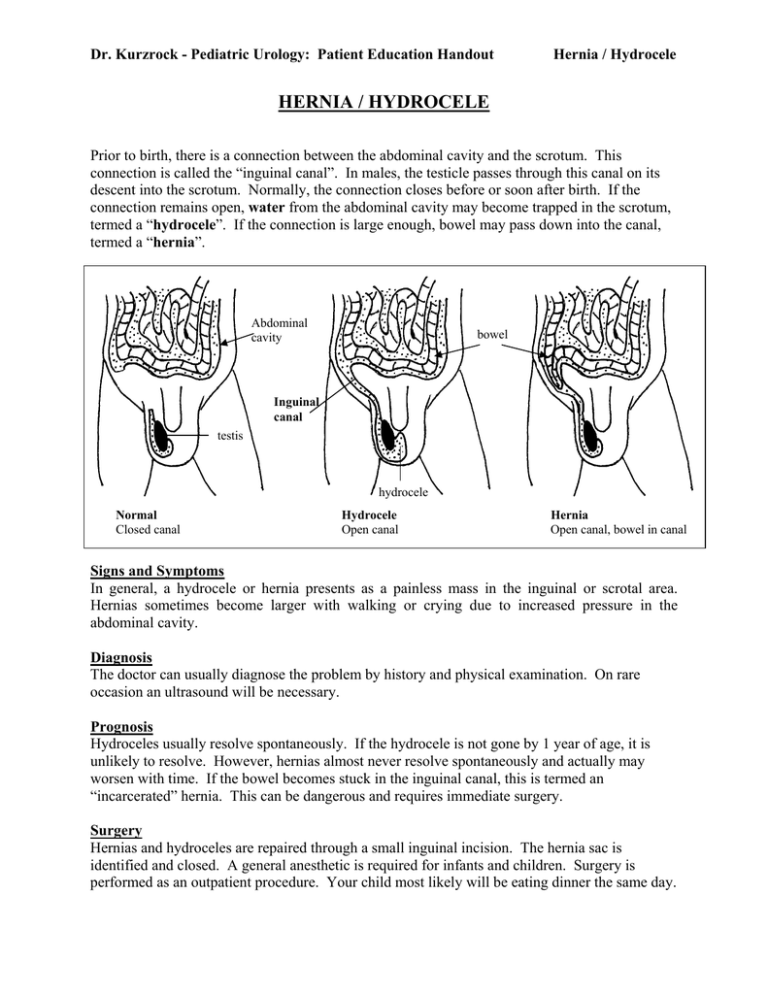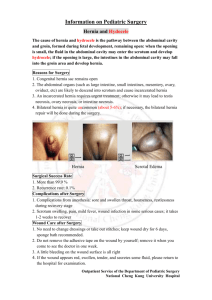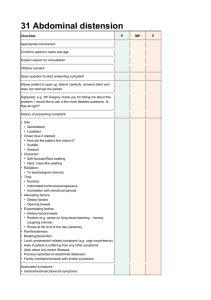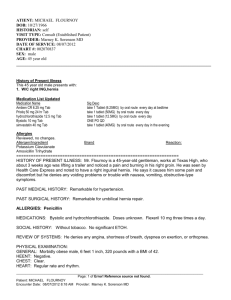HERNIA / HYDROCELE
advertisement

Dr. Kurzrock - Pediatric Urology: Patient Education Handout Hernia / Hydrocele HERNIA / HYDROCELE Prior to birth, there is a connection between the abdominal cavity and the scrotum. This connection is called the “inguinal canal”. In males, the testicle passes through this canal on its descent into the scrotum. Normally, the connection closes before or soon after birth. If the connection remains open, water from the abdominal cavity may become trapped in the scrotum, termed a “hydrocele”. If the connection is large enough, bowel may pass down into the canal, termed a “hernia”. Abdominal cavity bowel Inguinal canal testis hydrocele Normal Closed canal Hydrocele Open canal Hernia Open canal, bowel in canal Signs and Symptoms In general, a hydrocele or hernia presents as a painless mass in the inguinal or scrotal area. Hernias sometimes become larger with walking or crying due to increased pressure in the abdominal cavity. Diagnosis The doctor can usually diagnose the problem by history and physical examination. On rare occasion an ultrasound will be necessary. Prognosis Hydroceles usually resolve spontaneously. If the hydrocele is not gone by 1 year of age, it is unlikely to resolve. However, hernias almost never resolve spontaneously and actually may worsen with time. If the bowel becomes stuck in the inguinal canal, this is termed an “incarcerated” hernia. This can be dangerous and requires immediate surgery. Surgery Hernias and hydroceles are repaired through a small inguinal incision. The hernia sac is identified and closed. A general anesthetic is required for infants and children. Surgery is performed as an outpatient procedure. Your child most likely will be eating dinner the same day. Dr. Kurzrock - Pediatric Urology: Patient Education Handout Hernia / Hydrocele Risks The main risk of a hydrocele or hernia repair is injury to the blood vessels and reproductive duct going to the testicle. These vessels travel through the inguinal canal and are adherent to the hernia sac. Other possible complications include injury to the testicle, bladder or intestine. Pediatric surgical experience is very important in performing these procedures confidently and safely. Contralateral Hernia Children with hernias have an increased risk of developing a similar hernia on the other side. The risk is between 3 and 10% and may depend upon age, sex and side. This issue is very controversial in the pediatric surgical literature. There are multiple options in dealing with the other side, including: • Observation without surgery • Open exploration of the other side • Laparoscopy to determine if a hernia exists Other issues If your child has a hernia, be mindful of any abdominal pain, increased swelling, redness or unexplained fevers. These may indicate that the bowel is trapped (incarcerated) and possibly strangulated. If this happens, call your physician immediately.




